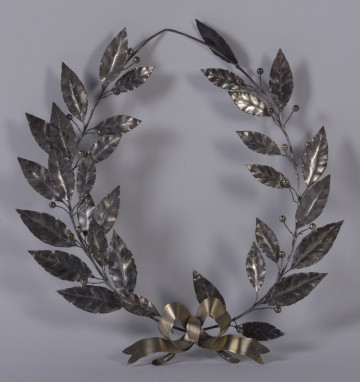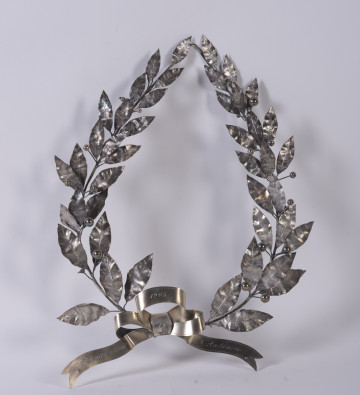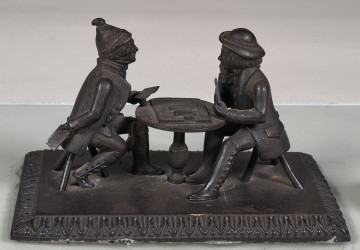
Laurel wreath
XIX/XX wiek
Castle Museum in Łańcut
Part of the collection: Metals
Goldsmithing: laurel wreath. Laurel wreath – a symbol of glory, fame, triumph and victory, also a reward for the winner in battle or sports competition. It was awarded to victorious leaders, artists, poets, scholars, and athletes. Over time, the laurel wreath became a symbol not only of victory, but also of outstanding achievements in all areas of life. In the Middle Ages, graduates were honoured with branches of fruiting laurel. A laurel wreath was awarded to outstanding writers (the so-called Capitoline Laurel – a distinction awarded to writers by emperors or popes) . A laurel wreath was awarded to outstanding writers (the so-called Capitoline Laurel – a distinction awarded to writers by emperors or popes)
In Christian art, laurel wreaths, as symbols of triumph and purity, adorned the heads of holy virgin-martyrs, as well as other martyrs. The laurel wreath also featured the monogram of Christ, indicating his victory over death, or the hand of God, which symbolized his immortality.
Laurel twigs and wreaths in funerary art are a symbol of immortality.
As a symbol of glory, the laurel wreath appeared in ancient Greece, but it was the Romans who popularized the custom of crowning emperors and victorious leaders, as well as eminent personalities of science and art, with laurels. Wreaths were also placed on the deceased, but in this way, they were provided with the protection of the gods. It was supposed to protect the deceased from bad adventures on this other world.
A wreath from the collection of the Museum-Castle in Łańcut was made of silver. It comes from the collection of the Potocki family taken over in 1944. A wreath of laurel leaves cut and embossed in silver sheet, flat mounted on a skeleton in the form of two silver rods – arms (visible on the reverse) running towards each other in an arc, connected at the base with a stiff, gilded bow. There are 42 leaves, arranged gradually from the largest to the smallest and there are 8 layers on each arm (in the first six in a trefoliate arrangement; in the outermost ones – difoliate and unifoliate). Between the leaves there are 7 laurel fruits, in the form of a small ball screwed onto a threaded rod. The bow is relatively large, symmetrically arranged in two levels, triangularly indented at the ends. Along the edges, there is a delicately engraved pattern of a simplified lambrequin ornament. On the 4 wings and the ribbon knot there is an engraved inscription: To Alfred Potocki, Marshal of the Land in 1875, in the name of the country.
"H.S" Viennese goldsmith. Austria-Vienna, 1889, 28x25
Yulia Dushka
Author / creator
Object type
metale
Technique
wytłaczanie
Material
brown
Creation time / dating
Creation / finding place
Owner
Muzeum - Zamek w Łańcucie
Identification number
Location / status

XIX/XX wiek
Castle Museum in Łańcut

Castle Museum in Łańcut

Castle Museum in Łańcut
DISCOVER this TOPIC
National Museum in Lublin
DISCOVER this PATH
Educational path